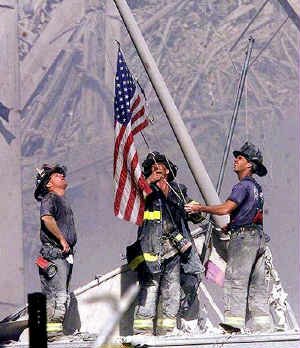|
I Pledge Allegiance to the flag of the United States of America and to the Republic for which it stands, one Nation under God, indivisible, with liberty and justice for all. A short explanation of the Pledge |
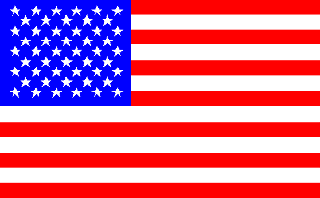 |
|
I am your Flag I was born on June 14th, 1777. I am more than just cloth shaped into a design. I am the refuge of the World's oppressed people. I am the silent sentinel of Freedom. I am the emblem of the greatest sovereign nation on earth. I am the inspiration for which American Patriots gave their lives and fortunes. I have led your sons into battle from Valley Forge to the bloody swamps of Viet Nam. I walk in silence with each of your Honored Dead, to their final resting place beneath the silent White Crosses, row upon row. I have flown through Peace and War, Strife and Prosperity, and amidst it all I have been respected. My Red Stripes . . . symbolize the blood spilled in defense of this glorious nation. My White Stripes . . . signify the burning tears shed by Americans who lost their sons. My Blue Field. . . is indicative of God's heaven under which I fly. My Stars . . . clustered together, unify 50 States as one, for God and Country. "Old Glory" is my nickname, and proudly I wave on high. Honor me, respect me, defend me with your lives and your fortunes. Never let my enemies tear me down from my lofty position, lest I never return. Keep alight the fires of patriotism, strive earnestly for the spirit of democracy. Worship Eternal God and keep His commandments, and I shall remain the bulwark of peace and freedom for all mankind. I am your Flag. |
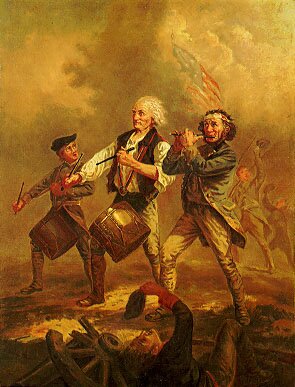 |
A Short History of the Flags of the United States
It was first decreed that there should be a star and a stripe for each state, making thirteen of both; for the states at the time had just been erected from the original thirteen colonies. The colors of the Flag may be thus explained: The red is for valor, zeal and fervency; the white for hope purity, cleanliness of life, and rectitude of conduct; the blue, the color of heaven, for reverence to God, loyalty, sincerity, justice and truth. The star (an ancient symbol of India, Persia and Egypt) symbolized dominion and sovereignty, as well as lofty aspirations. The constellation of the stars within the union, one star for each state, is emblematic of our Federal Constitution, which reserves to the States their individual sovereignty except as to rights delegated by them to the Federal Government. The symbolism of the Flag was thus interpreted by Washington: "We take the stars from Heaven, the red from our mother country, separating it by white stripes, thus showing that we have separated from her, and the white stripes shall go down to posterity representing Liberty." |
|
|
|
 |
Sons of Liberty The Sons of Liberty flew flags of Red and White Stripes. Some were vertical stripes while others were horizontal. The British often referred to flags of this type as the "rebellious stripes". Before the Contenental Congress made any kind of resolution determining the flag that the Americans would use, a wide variety of designs appeared. While most of the first flags were based loosely on British ensigns, the stars and stripes soon took hold. |
|
|
|
 |
Bennington Flag At the Battle of Bennington in August 1777 were two famous flags. One, shown here, is called the Bennington Flag or the Fillmore Flag. Nathaniel Fillmore took this flag home from the battlefield. The flag was passed down through generations of Fillmores, including Millard, and today it can be seen at Vermont's Bennington Museum. The other (not pictured) has a green field and a blue canton with 13 gold-painted stars arranged in rows. General John Stark gave his New Hampshire troops a rallying speech that would be the envy of any football coach today. He said, "My men, yonder are the Hessians. They were brought for seven pounds and ten pence a man. Are you worth more? Prove it. Tonight, the American flag floats from yonder hill or Molly Stark sleeps a widow!" |
|
What's with the Rattle Snakes?
The rattlesnake was the favorite animal emblem of Americans. American colonists saw the rattler as a good example of America's virtues. They argued that it is unique to America; individually its rattles produce no sound, but united they can be heard by all; and while it does not attack unless provoked, it is deadly when you distrub it or step upon it. Hence the motto "Don't Tread on Me"
|
|
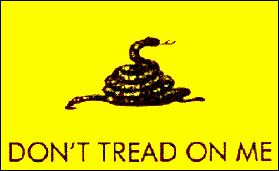 |
The Gadsden flag The Gadson flag was also used on vessels of the Continental Navy. Patriot Colonel Christopher Gadsden of South Carolina designed it, copying a design he saw on a banner. Commodore Esek Hopkins, commander of the new Continental fleet, carried a similar flag in February 1776, when his ships put to sea for the first time. Hopkins captured large stores of British cannon and military supplies in the Bahamas. His cruise marked the salt-water baptism of the American Navy and it saw the first landing of the Corps of Marines, on whose drums the Gadsden symbol was painted. |
|
|
|
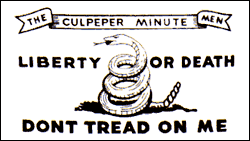 |
The Culpeper Flag (1775): A stylized version of the original "Don't Tread On Me Flag," supposedly used by the Culpeper Minutemen of Colonial America who had the slogan "Liberty or Death". While not proven, this may be the infamous flag which was flown by the first Minute Men to engage British troops in what shortly thereafter became the Revolutionary War. |
|
|
|
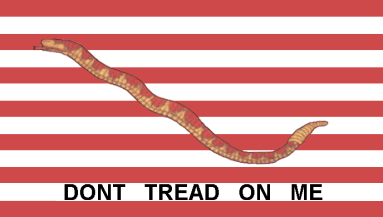 |
The First Navy Jack (1775): (also known as a Culpepper Flag) One of the first flags flown by our U.S. Navy may have been an adaptation of the "Rebellious Stripes" created at the time of the Stamp Act Congress. It featured thirteen red and white stripes. Stretched across them was the rippling form of a rattlesnake, and the words, "DON'T TREAD ON ME"- a striking indication of the colonists' courage and fierce desire for independence. |
|
A New Constellation
|
|
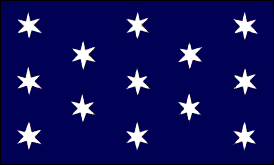 |
The Flag of George Washington. It became the symbol of our Union It was common practice for Generals to have a headquarters standard, and George Washington was no exception. The flag is thought to also have been the standard for the Colonial Army, as the flag was present at both Battle of Princeton and the Surrender of Yorktown. The original is in the collection of the Valley Forge Historical Society. |
|
The First Flags
On 14 June 1777, the Continental Congress adopted the following resolution: "RESOLVED, that the flag of the 13 United States be thirteen stripes, alternate red and white: That the union be thirteen stars, white in a blue field, representing a new constellation."The thirteen stars and thirteen stripes represented the thirteen original colonies: Connecticut - Delaware - Georgia - Maryland - Massachusetts - New Hampshire - New Jersey New York - North Carolina - Pennsylvania - Rhode Island - South Carolina - Virginia |
|
 |
Our First Official Flag
Betsy Ross Flag |
|
|
|
 |
Hopkinson Flag Believe it or not, there's evidence a civil servant designed our first flag! On June 14 , 1777 Continental Congress adopted the historic flag resolution, proposed by the marine committee, "that the flag of the thirteen United States be thirteen stripes, alternate red and white; that the union be thirteen stars, white in a blue field, representing a new constellation." No other details were specified. Francis Hopkinson, chairman of a department of the Congressional navy board, designed a flag using six-pointed stars in a staggered row configuration. (Note the similarity in the canton to George Washington’s flag.) |
|
|
|
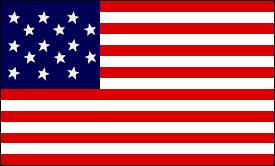 |
The Star Spangled Banner, the song that inspired our National Anthem Originally the flag measured 30 x 42 feet and flew from a flagpole about 90 feet high. The flag has 15 stars and 15 stripes as provided for by the Act of Congress approved January 13, 1794. Passage of the Act of Congress of April 4, 1818, reduced the number of stripes to 13 and provided for one star for each state--a new star to be added to the flag on the 4th of July following the admission of each new state. The Star-Spangled Banner is one of the very few 15-star, 15-stripe flags in existence. The original Star-Spangled Banner, the flag that inspired Francis Scott Key to write the words of our national anthem, today is the collections of the National Museum of American History at the Smithsonian Institution in Washington, D.C. (see National Anthem) |
|
|
|
 |
The Flag Today Today's Flag became the official flag of the United State on July 4, 1960: This was done by an Executive Order issued by President Dwight Eisenhower's Executive Order (#10834, published 25 August, 1959) Ike made it clear that older flags would still be considered American flags and could still be flown but the 50 Star flag was the official flag. However, Historic U.S. flags are due the same honor and respect that are given today's colors. When a historic flag is carried or displayed with a present-day flag, the modern flag takes precedence. |
